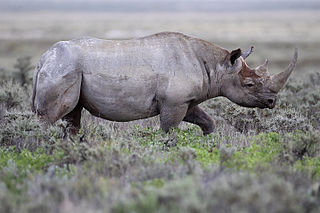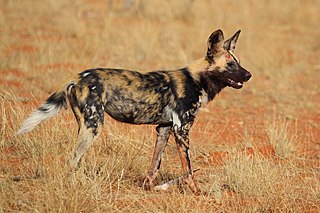
The San Diego Zoo Safari Park, originally named the San Diego Wild Animal Park until 2010, is an 1,800 acre zoo in the San Pasqual Valley area of San Diego, California, near Escondido. It is one of the largest tourist attractions in San Diego County. The park houses a large array of wild and endangered animals including species from the continents of Africa, Asia, Europe, North and South America, and Australia. This includes the largest collection of hoofed mammals in the world. The park is in a semi-arid environment, and one of its most notable features is the Africa Tram, which explores the expansive African exhibits. These free-range enclosures house such animals as antelopes, giraffes, buffalo, cranes, and rhinoceros. The park is also noted for its California condor breeding program.

Wildlife refers to undomesticated animal species, but has come to include all organisms that grow or live wild in an area without being introduced by humans. Wildlife was also synonymous to game: those birds and mammals that were hunted for sport. Wildlife can be found in all ecosystems. Deserts, plains, grasslands, woodlands, forests, and other areas, including the most developed urban areas, all have distinct forms of wildlife. While the term in popular culture usually refers to animals that are untouched by human factors, most scientists agree that much wildlife is affected by human activities. Some wildlife threaten human safety, health, property, and quality of life. However, many wild animals, even the dangerous ones, have value to human beings. This value might be economic, educational, or emotional in nature.

Oryx is a genus consisting of four large antelope species called oryxes. Their pelage is pale with contrasting dark markings in the face and on the legs, and their long horns are almost straight. The exception is the scimitar oryx, which lacks dark markings on the legs, only has faint dark markings on the head, has an ochre neck, and has horns that are clearly decurved.

The black rhinoceros, black rhino or hook-lipped rhinoceros is a species of rhinoceros, native to eastern and southern Africa including Angola, Botswana, Kenya, Malawi, Mozambique, Namibia, South Africa, Eswatini, Tanzania, Zambia, and Zimbabwe. Although the rhinoceros is referred to as black, its colours vary from brown to grey.

The hirola, also called the Hunter's hartebeest or Hunter's antelope, is a critically endangered antelope species found on the border between Kenya and Somalia. It was first described by the big game hunter and zoologist H.C.V. Hunter in 1888. It is the only living member of the genus Beatragus, though other species are known from the fossil record. The global hirola population is estimated at 300–500 animals and there are none in captivity. According to a document produced by the International Union for Conservation of Nature "the loss of the hirola would be the first extinction of a mammalian genus on mainland Africa in modern human history".

BirdLife International is a global partnership of non-governmental organizations that strives to conserve birds and their habitats. BirdLife International's priorities include preventing extinction of bird species, identifying and safeguarding important sites for birds, maintaining and restoring key bird habitats, and empowering conservationists worldwide.

The Wildlife Conservation Society (WCS) is a non-governmental organization headquartered at the Bronx Zoo in New York City, that aims to conserve the world's largest wild places in 14 priority regions. Founded in 1895 as the New York Zoological Society (NYZS), the organization is now led by President and CEO Cristián Samper. WCS manages four New York City wildlife parks in addition to the Bronx Zoo: the Central Park Zoo, New York Aquarium, Prospect Park Zoo and Queens Zoo. Together these parks receive 4 million visitors per year. All of the New York City facilities are accredited by the Association of Zoos and Aquariums (AZA).

William Temple Hornaday, Sc.D. was an American zoologist, conservationist, taxidermist, and author. He served as the first director of the New York Zoological Park, known today as the Bronx Zoo, and he was a pioneer in the early wildlife conservation movement in the United States.
Karl Ammann is a Swiss conservationist, wildlife photographer, author and documentary film producer. He initiated a campaign focusing on the African bush meat trade, which gained worldwide attention. As a conservation activist, he has specialized in investigative journalism involving undercover exposés dealing with the illegal wildlife trade. In the process, he has exposed NGOs and international conventions for their lack of effectiveness and the promotion of feel-good tales.
Chris Johns is a photographer and former editor-in-chief for National Geographic Magazine, a role he held from January 2005 to April 2014. After an internal reorganization at the organization, in April 2014, Johns was named chief content officer of National Geographic Society. He spent many years in Africa for the magazine and is the first photographer to have been named its editor-in-chief. He started his journalism career at daily newspapers.
East African Wild Life Society (EAWLS) is a membership-based non governmental conservation organization. It was founded in 1961 following the amalgamation of the Wildlife Societies of Kenya and Tanzania.

The African wild dog, also called the painted dog or painted wolf, and the Cape hunting dog, is a wild canine which is a native species to sub-Saharan Africa. It is the largest wild canine in Africa, and the only extant member of the genus Lycaon, which is distinguished from Canis by dentition highly specialised for a hypercarnivorous diet, and by a lack of dewclaws. It is estimated that about 6,600 adults live in 39 subpopulations that are all threatened by habitat fragmentation, human persecution, and outbreaks of disease. As the largest subpopulation probably comprises fewer than 250 individuals, the African wild dog has been listed as endangered on the IUCN Red List since 1990.
The Wildlife and Environment Society of South Africa is a non-government environmental organization (NGO) of South Africa, established in 1926, although its origins go back to the 1890s.

The Lugenda or Lujenda is a river of northern Mozambique. It flows in a south-north direction from Lake Amaramba/Lake Chiuta and is the largest tributary of the Ruvuma River. It joins the Luambala River at 13°26′12″S36°18′20″E. The river valley is reported to be only 800 feet (240 m) above sea level. North of Lake Chiuta, those on the west bank call it the Msambiti River. At one point, the Lugenda splits into several streams with islands between them, some of whom are populated such as the island Achemponda.
The Ewaso Lions Project was founded in 2007 for the protection of lions and their habitat in Northern Kenya. The project works to study and incorporate local communities in helping to protect the lions in the Samburu National Reserve, Buffalo Springs National Reserve and Shaba National Reserve of the Ewaso Nyiro ecosystem in Northern Kenya.
Nigel Degge Wilmot Sitwell was an English conservationist, writer, editor and businessman specialising in wildlife and travel. He is noted for his travels in nearly 100 countries, including Antarctica, Tibet, East Africa and East Asia. In addition he edited and published the WWF magazine series Wildlife for 17 years.

The Northeast African cheetah is a cheetah subspecies occurring in Northeast Africa. Contemporary records are known in South Sudan and Ethiopia, but population status in Eritrea, Djibouti, Somalia and Sudan is unknown.

Pete Oxford is a British-born conservation photographer based in Quito, Ecuador. Originally trained as a marine biologist, he and his wife, South African-born Reneé Bish, now work as a professional photographic team focusing primarily on wildlife and indigenous cultures.
National Geographic Global Networks is a business unit within National Geographic Partners and Disney General Entertainment Content that oversees the National Geographic-branded television channels: National Geographic, Nat Geo Kids, Nat Geo Music, Nat Geo People and Nat Geo Wild and National Geographic Studios. The unit itself was a joint operation between 21st Century Fox (21CF) and the Society, but it was later integrated into the new joint venture National Geographic Partners which they formed in 2015. On March 20, 2019, 21CF's share in National Geographic Partners was assumed by Disney, following its acquisition of most 21CF businesses.











